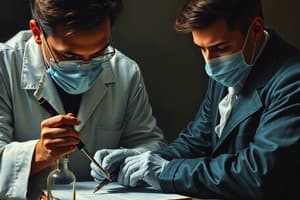Podcast
Questions and Answers
What is a primary reason for avoiding sitting in a vehicle during examination?
What is a primary reason for avoiding sitting in a vehicle during examination?
- To ensure tools are not left inside
- To keep the seats clean for future use
- To prevent the transfer of fibers from clothing (correct)
- To avoid contamination with fingerprints
What type of evidence can marks be categorized as?
What type of evidence can marks be categorized as?
- Evidence types such as footwear and fingerprints (correct)
- Only marks made on hard surfaces
- Only visible marks made by tools
- Only shoe prints and tool marks
Why should you not attempt to fit a recovered tool into an instrument mark?
Why should you not attempt to fit a recovered tool into an instrument mark?
- It could destroy the evidence in the mark (correct)
- It may lead to misidentification of the tool
- It risks leaving more marks on the tool
- It may not fit correctly due to its age
What can enable almost any mark to be linked to the item that made it?
What can enable almost any mark to be linked to the item that made it?
What does the strength of the evidence from paint or glass depend on?
What does the strength of the evidence from paint or glass depend on?
What is a consequence of two surfaces coming into firm contact with each other?
What is a consequence of two surfaces coming into firm contact with each other?
What role do unique characteristics of tools play in forensic investigations?
What role do unique characteristics of tools play in forensic investigations?
What should you do if you see instrument marks at a crime scene?
What should you do if you see instrument marks at a crime scene?
What principle did Dr. Edmond Locard formulate regarding evidence at crime scenes?
What principle did Dr. Edmond Locard formulate regarding evidence at crime scenes?
What role does trace evidence play in a criminal investigation?
What role does trace evidence play in a criminal investigation?
How can contamination affect a crime scene?
How can contamination affect a crime scene?
What is the primary purpose of preserving trace evidence at a crime scene?
What is the primary purpose of preserving trace evidence at a crime scene?
Which of the following can be considered potential types of trace evidence?
Which of the following can be considered potential types of trace evidence?
What does careful examination of a crime scene aim to achieve?
What does careful examination of a crime scene aim to achieve?
What can trace evidence often serve as in a criminal investigation?
What can trace evidence often serve as in a criminal investigation?
Which of the following statements is true regarding the importance of trace evidence?
Which of the following statements is true regarding the importance of trace evidence?
Which of the following media can fingerprints be found in?
Which of the following media can fingerprints be found in?
What should be done if broken glass at a crime scene cannot be protected from the weather?
What should be done if broken glass at a crime scene cannot be protected from the weather?
What is the unique characteristic of DNA in individuals?
What is the unique characteristic of DNA in individuals?
When retrieving items that may contain DNA, what should be done to prevent contamination?
When retrieving items that may contain DNA, what should be done to prevent contamination?
How should broken glass be handled to preserve fingerprints?
How should broken glass be handled to preserve fingerprints?
Where can DNA be retrieved from?
Where can DNA be retrieved from?
Why is it important to inform the Scene Examiner or Crime Scene Manager when moving an article?
Why is it important to inform the Scene Examiner or Crime Scene Manager when moving an article?
What type of acid is Deoxyribo-Nucleic Acid (DNA)?
What type of acid is Deoxyribo-Nucleic Acid (DNA)?
What type of evidence is commonly linked with housebreakings and vandalisms?
What type of evidence is commonly linked with housebreakings and vandalisms?
Why is it crucial to recover clothing and footwear from a suspect quickly?
Why is it crucial to recover clothing and footwear from a suspect quickly?
What can cause contamination of contact evidence at a crime scene?
What can cause contamination of contact evidence at a crime scene?
What is one consequence if contamination of evidence occurs?
What is one consequence if contamination of evidence occurs?
Which procedure should be followed regarding the transportation of victims and suspects?
Which procedure should be followed regarding the transportation of victims and suspects?
What happens to paint evidence in a road traffic accident?
What happens to paint evidence in a road traffic accident?
Which of the following best describes evidence at crime scenes?
Which of the following best describes evidence at crime scenes?
What is the primary risk when visiting a crime scene?
What is the primary risk when visiting a crime scene?
What is one of the primary concerns when handling evidence at a crime scene?
What is one of the primary concerns when handling evidence at a crime scene?
Which of the following is NOT one of the three phases of initial actions at crime scenes?
Which of the following is NOT one of the three phases of initial actions at crime scenes?
Which entry should typically be made in a Scene Entry Log at a crime scene?
Which entry should typically be made in a Scene Entry Log at a crime scene?
What should be a primary focus when preserving evidence at a crime scene?
What should be a primary focus when preserving evidence at a crime scene?
What is a potential consequence of contamination at a crime scene?
What is a potential consequence of contamination at a crime scene?
Which of the following is an example of a health and safety consideration at a crime scene?
Which of the following is an example of a health and safety consideration at a crime scene?
Why is it important to document entries in the Scene Entry Log?
Why is it important to document entries in the Scene Entry Log?
Which type of evidence is critical to collect without delay?
Which type of evidence is critical to collect without delay?
Flashcards are hidden until you start studying
Study Notes
Lesson Aim and Learning Outcomes
- Aim: Explain evidential considerations within crime scenes.
- Outcomes include explaining types of potential evidence, understanding contamination effects, identifying fingerprint sources, and noting initial actions and safety considerations.
Locard’s Exchange Principle
- "Every contact leaves a trace" principle links people or objects to crime scenes.
- Trace evidence is crucial for investigations, serving as initial leads.
Types of Potential Evidence
- Trace Evidence: Links people or objects through materials like hair, fibers, and debris.
- Fingerprints: Can be recovered from surfaces including glass, metal, and paper.
- DNA Evidence: Unique to each individual (except identical twins), can be obtained from many items (e.g., cups, clothing).
- Marks: Include tools and footwear impressions; can be matched to the items that made them.
Preservation of Evidence
- Glass at crime scenes should be protected from contamination and handling.
- DNA evidence requires avoidance of contamination, including not sitting in vehicles.
- Instrument marks should not be tampered with; cover them if weather conditions might damage them.
- Paint and glass fragments are lost quickly, necessitating prompt recovery from suspects.
Impact of Contamination
- Contamination can significantly reduce the evidential value of contact evidence.
- Strict protocols are advised to prevent contamination, such as not transporting victims and suspects together.
Initial Actions and Health & Safety Considerations
- Identify three crucial phases upon arriving at a crime scene.
- Maintain a detailed Scene Entry Log and crime scene notebook.
- Follow Health and Safety guidelines to ensure personal and team safety during investigations.
Conclusion
- Understanding evidential considerations is vital for successful crime scene investigations.
Studying That Suits You
Use AI to generate personalized quizzes and flashcards to suit your learning preferences.



